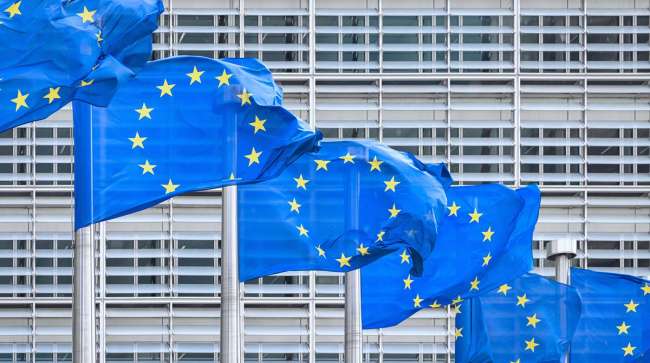European Union flags at the European Commission in Brussels. (Mlenny/Getty Images)
The European Union and U.S. made scant progress bridging trade differences this week as officials from President Donald Trump’s administration indicated that the bulk of the U.S. tariffs imposed on the bloc will not be removed.
The EU’s trade chief, Maros Sefcovic, left the meeting with little clarity on the U.S. stance, struggling to determine the American side’s aims, according to people familiar with the discussions. He met for about two hours with U.S. Commerce Secretary Howard Lutnick and Trade Representative Jamieson Greer in Washington on April 14.
The U.S. officials indicated that the 20% “reciprocal” tariffs — which have been reduced to 10% for 90 days — as well as other tariffs targeting sectors including cars and metals would not be removed outright, said the people, who spoke on the condition of anonymity.
Trump announced a sweeping array of tariffs this month in his bid to reorder the global trading system, bring manufacturing jobs back to the U.S. and raise revenue to pay for a tax-cut extension. His administration has also moved forward with plans to impose semiconductor and pharmaceutical imports with duties. All of Trump’s new tariffs are hitting around 380 billion euros ($431 billion) of EU goods.

An official with the U.S. Trade Representative said their office does not disclose the content of negotiations. A spokesperson for the Commerce secretary didn’t immediately reply to a request for comment. A spokesperson for the European Commission declined to comment.
The EU agreed last week to delay for 90 days the implementation of a set of counter-tariffs against the U.S. over 25% duties Trump imposed on the bloc’s steel and aluminum exports. The move came after the U.S. president lowered his so-called reciprocal rate on most EU exports for the same amount of time.
The EU has said that its measures, which target around 21 billion euros of U.S. goods, will snap into place after the 90 days if negotiations don’t yield satisfactory results. The bloc is already working to prepare more countermeasures in the event of that scenario materializing. In parallel, it is rushing to conclude trade deals with countries around the world and improve the functioning of its single market.
While U.S. officials have suggested that the sectoral measures had to stay, some of the tariffs on cars could be offset by increasing investments, production and exports from the U.S., the people said. They speculated, however, that there was no stopping the levies from getting increased in the future should U.S. exports not get a boost.
In D.C., met with Secretary @howardlutnick and Ambassador @jamiesongreer for 🇪🇺🇺🇸 negotiations, seizing the 90-day window for a mutual solution to unjustified tariffs. 1/2 pic.twitter.com/P0eMgZSudQ
— Maroš Šefčovič🇪🇺 (@MarosSefcovic) April 14, 2025
The EU has offered that both sides remove all tariffs on industrial goods, including cars. The U.S. has so far rejected that proposal.
The U.S. imported more than $52.3 billion worth of new vehicles from the EU last year, according to Commerce Department data. Much of the $11.3 billion worth of autos that the U.S. exported to the bloc were sport utility vehicles built by German manufacturers BMW AG and Mercedes-Benz Group AG.
Trump has repeatedly attacked the EU, the U.S.’s largest trading partner when counted as a bloc, saying it was formed to “screw” the U.S. and that the bloc’s trade-in-goods surplus is evidence of an unfair relationship. The EU’s trade weighted average tariff rate was 2.7% in 2023, according to World Trade Organization data.
The U.S. would like to see European chemical firms produce more precursors used in the pharmaceutical industry in the U.S., integrate supply chains, have preferential procurement and suggested the bloc should increase the price of its medicines, the people said.
U.S. Vice President JD Vance has previously said that Europe pays less for many of its drugs because Americans are subsidizing its health care.
On steel and aluminum, as well as potential future levies on copper, the U.S. wants the EU to come forward with a proposal, while floating the possibility of common tariffs, according to the people. They said it wasn’t clear whether some of the ideas floated had wider backing within the administration but noted several were not compatible with WTO rules.
The commission has been working on a “term sheet” of potential areas for negotiation, including lower tariffs, regulations and standards, Bloomberg previously reported.
The EU has also proposed increasing purchases of liquefied natural gas from the U.S., but Trump officials have so far shown little appetite in exploring that route as an alternative to tariffs.
Trump, however, suggested earlier this month that energy purchases could help cut the EU’s trade surplus with the U.S. He said the U.S. deficit “can disappear easily and quickly” because the EU needs American energy.
“They have to buy and commit to buy a like amount of energy,” he said. “And we have that.”
U.S. officials have insisted on discussing what Washington perceives as non-tariff barriers such as digital and artificial intelligence regulations as well as food standards, the people said. Discussions between the two sides will continue at a technical level.






